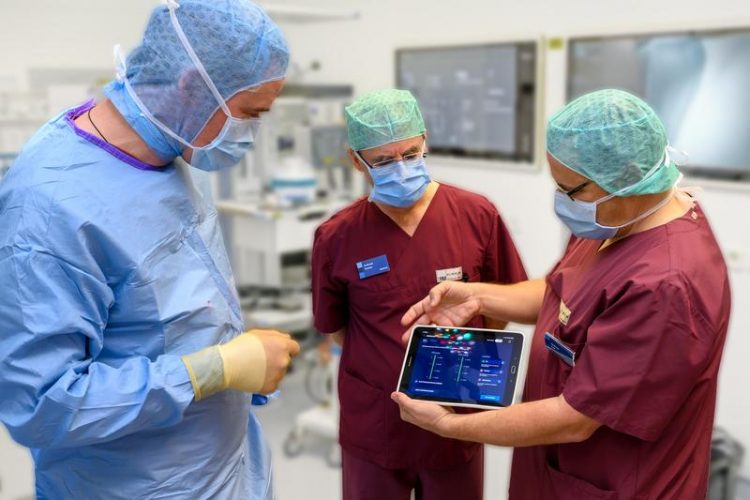World’s first Parkinson’s patient treated with unique Deep Brain Stimulation device

Doctors control the activity of the pacemaker on the tablet LMU University Hospital Munich
Deep Brain Stimulation (DBS) is delivered through a medical device, similar to a pacemaker, that controls electrodes in the brain and electrically stimulates precisely defined areas. DBS has been used to treat neurological movement disorders for decades. This new generation of THS systems was now first placed in the subthalamic nucleus (STN) of a patient suffering from Parkinson's.
The system does not only deliver impulses to the brain, it also features the so-called BrainSense technology that enables the constant recording of patients’ brain signals. These recordings can then be evaluated by a physician to optimize stimulation delivery. Up until now, recordings of this kind were not possible.
Treatment plans were optimized based on movement tests carried out in the clinic and – often incomplete – patient records. This new technology allows for brain waves to be continuously recorded, which combined with events recorded by the patient himself (including symptoms or side effects of medication), now enable targeted, personalized and data-controlled neurostimulation.
“DBS is proven to significantly improve motor function in people with Parkinson’s disease compared to standard medication alone and has successfully been used for many years in the treatment of neurological movement disorders,” says PD Dr. Jan H. Mehrkens, Head of Functional Neurology at the LMU Clinic for Neurosurgery in Munich.
“Since we were already able to gain experience with the prototype during clinical studies, we have now come full circle in the development of new DBS technologies for Parkinson's patients.” Prof. Dr. Kai Boetzel, LMU clinic for Neurology added: “The new stimulator can measure the activity of the brain’s motor centers and react to it with different stimulation strengths. We will scientifically investigate, whether this ‘feedback stimulation’ is superior to the previous continuous stimulation.”
Parkinson's disease is the second most common disorder of the central nervous system after Alzheimer's disease. Around one percent of the world’s population over the age of 60 is affected. In Germany roughly 400,000 people suffer from it. Parkinson's disease is a slowly progressing condition.
Gradually, the death of dopamine-producing nerve cells negatively affects the motor system. Parkinson's itself cannot be healed, therapy focuses on alleviating the symptoms. Treatment typically starts with medication to help reduce movement symptoms by increasing dopamine in the brain or mimicking its effects. When the disease has progressed, there are surgical options that include DBS.
Percept BrainSense
The neurostimulator with “BrainSense” technology is approved in the EU for the treatment of symptoms in connection with Parkinson's disease, essential tremor, dystonia, epilepsy and obsessive-compulsive disorder. For approval in the United States, it is currently under review by the United States Department of Health (FDA).
PD Dr. Jan-Hinnerk Mehrkens
LMU Clinic for Neurosurgery
LMU University Hospital Munich
Phone: +49 (0)89 4400 72899
E-mail: jan.mehrkens@med.uni-muenchen.de
Prof. Dr. Kai Boetzel
LMU Clinic for Neurology
LMU University Hospital Munich
Phone: +49 (0)89 4400 73673
E-mail: kai.boetzel@med.uni-muenchen.de
Media Contact
More Information:
http://www.klinikum.uni-muenchen.deAll latest news from the category: Medical Engineering
The development of medical equipment, products and technical procedures is characterized by high research and development costs in a variety of fields related to the study of human medicine.
innovations-report provides informative and stimulating reports and articles on topics ranging from imaging processes, cell and tissue techniques, optical techniques, implants, orthopedic aids, clinical and medical office equipment, dialysis systems and x-ray/radiation monitoring devices to endoscopy, ultrasound, surgical techniques, and dental materials.
Newest articles

Combatting disruptive ‘noise’ in quantum communication
In a significant milestone for quantum communication technology, an experiment has demonstrated how networks can be leveraged to combat disruptive ‘noise’ in quantum communications. The international effort led by researchers…

Stretchable quantum dot display
Intrinsically stretchable quantum dot-based light-emitting diodes achieved record-breaking performance. A team of South Korean scientists led by Professor KIM Dae-Hyeong of the Center for Nanoparticle Research within the Institute for…

Internet can achieve quantum speed with light saved as sound
Researchers at the University of Copenhagen’s Niels Bohr Institute have developed a new way to create quantum memory: A small drum can store data sent with light in its sonic…





















